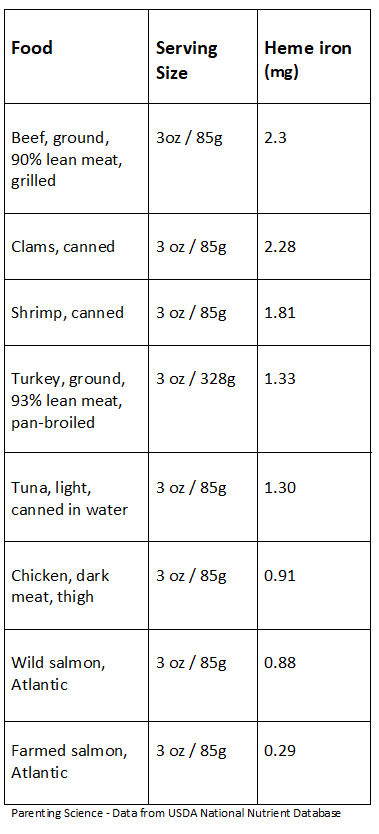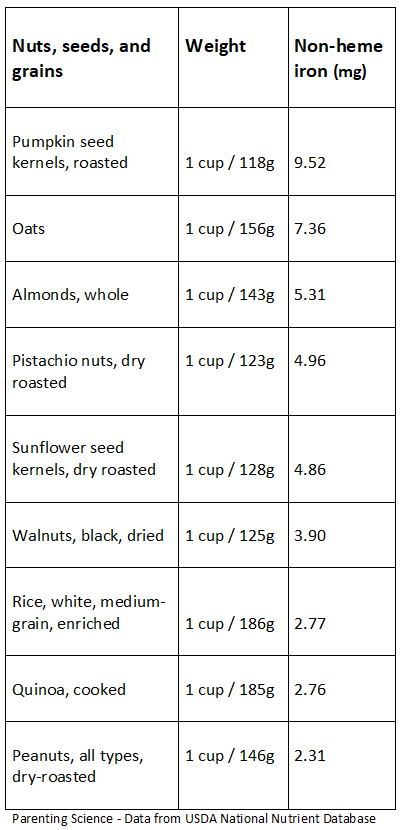Iron rich foods: How to improve children's iron status through diet
© 2009 – 2021, Gwen Dewar, Ph.D., all rights reserved
 opens IMAGE file
opens IMAGE file
The smart consumption of atomic number 26 rich foods
If your child has been diagnosed with an fe deficiency, it makes sense to examine his or her nutrition. But boosting iron levels isn't but a affair of eating iron-rich foods.
Some foods contain fe, simply they besides incorporate compounds that decrease the body's ability to absorb iron.
For instance, many grains, legumes, and vegetables comprise phytates, chemical compounds which demark to iron.
Once leap together, these phytate-iron complexes can't be digested by man enzymes in the gut — at least not if the pH of gut is in the neutral range. Every bit a issue, the atomic number 26 you consume may end upward passing through your body — unabsorbed (Petroski and Minich 2020).
In addition, tannins (constitute in tea, and in diverse fruits and vegetable foods) can inhibit iron absorption. So tin sure proteins establish in eggs.
So while we often hear that eggs and spinach are proficient sources of iron, the reality is more complicated. Experiments and laboratory analyses indicate that the fe in these foods is rather poorly-absorbed (Gordon and Chow 1984; Insel et al 2004; Ishikawa et al 2007).
And then there'southward the problem of calcium and milk products.
Calcium competes with iron for absorption past the body (Insel et al 2004), so a calcium-rich meal can temporarily cake iron absorption (Lönnerdal 2010).
And the effect may be amplified if a child consumes cow'south milk. In addition to calcium, moo-cow'southward milk contains a protein called alpha-casein that has an inhibitory effect on atomic number 26 absorption (Kibangou et al 2005).
This may explicate, at to the lowest degree in role, a well-known risk factor for fe deficiency in children: Kids who consume lots of moo-cow'south milk are more likely to suffer from an iron deficiency (Uijterschout et al 2014; Gunnarson et al 2007; Hallberg 1998).
For example, in a study of Canadian children, toddlers were more likely to suffer from an atomic number 26 deficiency if they were in the addiction of consuming more than two cups of cow'south milk per 24-hour interval (Cox et al 2016).
What about immature infants? They brainstorm life on a diet of milk. How tin can babies avoid atomic number 26 deficiency?
Babies are built-in with iron stores that assist keep them remain atomic number 26-sufficient during the showtime few months postpartum.
And breast milk — despite its calcium content — is really a good source of iron for infants. Although chest milk contains relatively low concentrations of iron (well-nigh 0.35 mg/L), information technology doesn't contain the fe absorption inhibitor alpha casein.
Moreover, the fe in homo breast milk comes in a form that is highly bioavailable, or easily-absorbed. In fact, researchers estimate that babies may be able to blot anywhere from 45-100% of the iron in their chest milk (Qasem and Friel 2015).
Even so, by the time breastfed infants are half dozen months old, their iron stores may be depleted. And the amount of iron they are getting from chest milk isn't sufficient to keep up.
And then researchers recommend that these babies begin consuming supplemental foods that are rich in iron (Qasem and Friel 2015).
Are there whatsoever foods that heighten iron absorption?
Yep. Vitamin C and "meat cistron" (found in reddish meat, salmon, and other animal musculus proteins) help the body blot iron and counteract the effects phytates.
In 1 study, adding 63 mg of vitamin C to a grain-based, iron-rich repast boosted iron assimilation past almost 300% (Fidler et al 2009).
And then what'southward a good dietary strategy for boosting iron levels?
- Avoid the consumption of loftier levels of calcium (>40 mg) during meals that are intended to heave iron levels.
- Avoid other iron absorption inhibitors, like peppermint, chamomile, tea, and coffee.
- Encourage your kid to consume iron-rich foods in combination with sources of vitamin C (like citrus fruits, peaches, papayas, sweet red peppers, berries, broccoli, and peas).
What kinds of iron-rich foods are appropriate for babies and toddlers?
Your baby's get-go foods will be mashed-upward. Pureed meats are rich in iron. Infants can likewise obtain some atomic number 26 from non-meat sources — like mashed tofu, pureed green beans, strained peas, and pureed sweetness potato. There are also iron-fortified cereals designed specifically for young infants.
As your child gets older, you can innovate more than textured foods, only yous volition nonetheless need to be mindful of choking hazards.
For example, every bit I note in a table below, stale fruits are expert sources of iron. But they should exist avoided by babies and immature toddlers, because can get stuck in a child's throat.
For an evidence-based discussion of how to introduce solids, see opens in a new windowthis Parenting Science article.
What about meat? Practice we have to swallow meat to avoid iron deficiency?
 opens Prototype file
opens Prototype file
Non if you lot are careful to go iron from other sources. But it's worth noting that some families who avert red meat may find information technology more difficult to maintain target iron levels.
For case, in a study of more than 250 Israeli children, researchers establish that kids who ate red meat rarely had a fourfold increased chance of beingness atomic number 26 deficient (Moshe et al 2013). If you have concerns nigh iron deficiency and red meat isn't on your menu, you may want to take special note of this evidence-based advice.
Which foods are especially rich in fe? How practice different foods compare?
There are two classes of atomic number 26 rich foods. Foods that contain heme iron, and foods that incorporate non-heme iron. Let's take a closer await.
Fe rich foods: Sources of heme iron
Heme atomic number 26 is the form of iron most hands absorbed by the body. It is constitute in animal muscle tissue. Here are some specific examples of heme iron rich foods, as rated by the USDA Nutrient Database.

Fe rich foods: Sources of nonheme atomic number 26
Nonheme iron is constitute in plant foods, as well as in meat and eggs. Compared with heme iron, nonheme atomic number 26 is much less efficiently absorbed.
Moreover, many sources of nonheme fe also incorporate phytates, which greatly reduce bioavailability. If you want to blot significant quantities of nonheme iron, it'southward especially important to combine information technology with vitamin C or meat. Over again, see my article on opens in a new windowiron absorption for more information.
I've created several charts with examples of nonheme, iron-rich foods. Both are compiled from information provided by the USDA Nutrient Database.
In this starting time nautical chart, I highlight beans, peas, and lentils. Be aware that they pose a choking hazard to babies. Yous'll desire to brew them.
Tip for reducing phytates in these foods: Research suggests we tin reduce phytate levels by cooking them for one hr at 95 degrees Celsius or 205 degrees Farenheit (Petroski and Minich 2020).
In improver, studies indicate that the regular consumption of fermentable fibers lowers the pH of the caecum, which tin can brand it easier to absorb fe. Beans typically contain lots of fermentable fibers, so if yous brand a habit of eating beans, your body may absorb nonheme iron more than efficiently (Petroski and Minich 2020).

In this second chart, I highlight the nonheme iron content in some basics, seeds, and grains. In one case again, be mindful of choking hazards. Babies and younger toddlers shouldn't eat nuts or seeds. And annotation that some children are allergic to tree basics and/or peanuts, so you should consult your pediatrician virtually what foods are appropriate for your kid.

Finally, here are ii charts highlighting a few fruits and vegetables. As e'er, be aware of choking hazards for babies and young toddlers. Dried fruits, for example, tin can go stuck in a child'southward pharynx.


These tables represent just a pocket-size sampling of foods. For a more extensive listing of iron rich foods, cheque out the USDA Food Database for yourself.
Yous can admission as a PDF via opens in a new windowthis link.opens PDF file
References: Iron-rich foods
Bailey RL, Catellier DJ, Jun Due south, Dwyer JT, Jacquier EF, Anater Every bit, Eldridge AL. Total usual food intakes of US children (nether 48 months): findings from the Feeding Infants and Toddlers Report (FITS) 2016. J Nutr 2018;148:1557S–66S.
Cox KA, Parkin PC, Anderson LN, Chen Y, Birken CS, Maguire JL, Macarthur C, Borkhoff CM. 2016. Clan Between Meat and Meat-Alternative Consumption and Iron Stores in Early Childhood. TARGet Kids! Collaboration. Acad Pediatr. 16(8):783-791.
Fidler MC, Davidsson L, Zeder C, and Hurrell RF. 2004. Erythorbic acrid is a stiff enhancer of nonheme-iron absorption. Am J Clin Nutr. 2004 January;79(1):99-102.
Gordon DT and Chao LS. 1984. Relationship of components in wheat bran and spinach to iron bioavailability in the anemic rat. Journal of Nutrition 114(3): 526-535.
Gunnarsson BS, Thorsdottir I,and Palsson 1000. 2007. Associations of iron status with dietary and other factors in half-dozen-year-old children. Eur J Clin Nutr. 61(3):398-403.
Hallberg L. 1998. Does calcium interfere with atomic number 26 absorption? Am. J. Clin. Nutr. 68: iii-four.
Insel, PM, Turner RE, and Ross D. 2003. Diet. second edition.
Ishikawa SI, Tamaki S, Arihara K, Itoh Grand. 2007. Egg yolk protein and egg yolk phosvitin inhibit calcium, magnesium, and atomic number 26 absorptions in rats. J Food Sci. 72(6):S412-nine.
Kibangou IB, Bouhallab S, Henry G, Agency F, Allouche S, Blais A, Guérin P, Arhan P, Bouglé DL. 2005. Milk proteins and iron absorption: contrasting furnishings of different caseinophosphopeptides. Pediatr Res. 58(four):731-iv.
Moshe M, Amitai Y, Korchia Thousand, Korchia 50, Tenenbaum A, Rosenblum J, Schechter A. 2013. Anemia and atomic number 26 deficiency in children: association with reddish meat and poultry consumption. J Pediatr Gastroenterol Nutr. 57(half-dozen):722-vii.
Petroski W and Minich DM. Is In that location Such a Thing as "Anti-Nutrients"? A Narrative Review of Perceived Problematic Constitute Compounds. 2020. Nutrients. 12(10):2929.
Qasem WA and Friel JK. 2015. An Overview of Iron in Term Breast-Fed Infants. Clin Med Insights Pediatr. 9:79-84.
Rutzke CJ, Glahn RP, Rutzke MA, Welch RM, Langhans RW, Albright LD, Combs GF Jr, and Wheeler RM. 2004. Bioavailability of iron from spinach using an in vitro/human Caco-2 prison cell bioassay model. Abode (Elmsford). ten(1):7-i.
Uijterschout 50, Vloemans J, Vos R, Teunisse PP, Hudig C, Bubbers S, Verbruggen S, Veldhorst M, de Leeuw T, van Goudoever JB, Brus F. 2014. Prevalence and chance factors of atomic number 26 deficiency in healthy young children in the southwestern Netherlands. J Pediatr Gastroenterol Nutr. 58(2):195-200.
van der Merwe LF and Eussen SR. 2017. Iron status of young children in Europe. Am J Clin Nutr. 106(Suppl six):1663S-1671S.
Content terminal modified three/2021
Source: https://parentingscience.com/iron-rich-foods/
0 Response to "Iron rich foods: How to improve children's iron status through diet"
Post a Comment